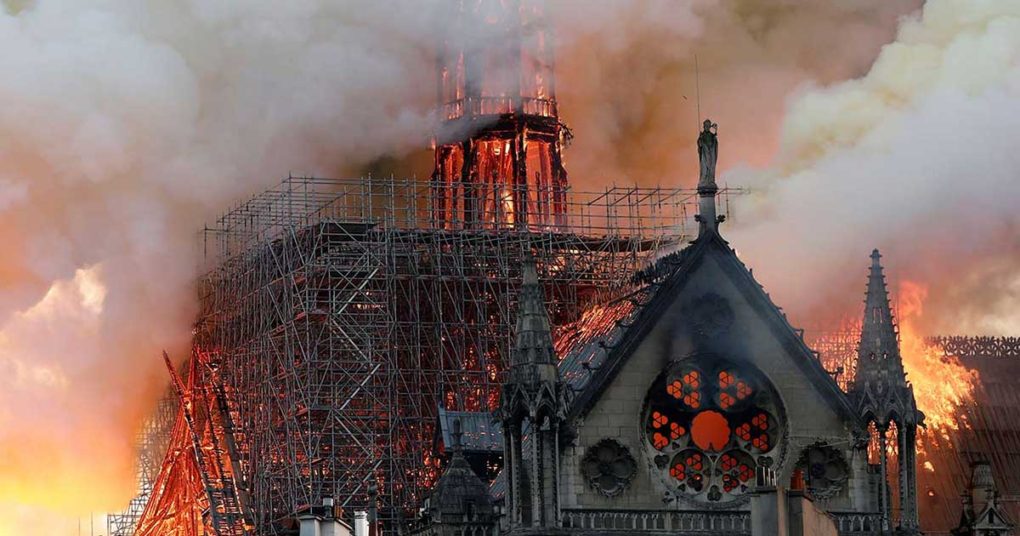“Notre-Dame est toujours debout”, exclaimed Archbishop Michel Aupetit of Paris during Holy Week, in the days following the terrible fire at the iconic Cathedral. The words mean literally that “Notre-Dame is still standing” but also have the sense that “Our Lady still stands” – at the foot of the Cross.
As the French discovered in the aftermath of the fire, and perhaps a little to their surprise, millions of people around the world felt a great connection to their beloved cathedral. Although an enthusiastic Francophile since my youth, I had forgotten that the screensaver on my own laptop was a photo from Paris, with the two towers of Notre-Dame in the background! As an occasional visitor to the French capital, I loved to visit Notre-Dame but also to walk along the river near the Cathedral and to view the extraordinary building from different angles as I strolled by the Seine.
I found the words of Archbishop Aupetit after the fire uplifting and inspiring, at what must have been a time of anguish for him. The Archbishop is a former GP who was ordained to the priesthood in his forties. In his beautiful message to the Catholics of Paris just after the fire, the Archbishop said:
France weeps, and, with her, all her friends from the whole world. She is touched in her heart because these stones are the witness of an invincible hope, which, through the talent, the courage the genius and the faith of the builders, raised this luminous lacework of stones, wood and glass. That faith remains our faith. It is the faith that moves mountains and will permit us to rebuild this masterpiece.
He went on to highlight the need to rebuild not only the Cathedral but also “our Church, whose face is so disfigured”.
The French Catholic TV station KTO provided precious access to the Holy Week ceremonies in Paris. KTO lost substantial equipment in Notre Dame and had to re-group quickly in order to be able to continue with its services at the church of Saint-Sulpice, where the Chrism Mass and other ceremonies were transferred with great urgency.
At this Chrism Mass, the Archbishop linked the cathedral and the human person. The cathedral was not just a heap of stones and the human person is not just a collection of molecules. Both have a principle of organization. Both have received anointing. Both are vessels of a Presence. The Cathedral is the House of God and the house of all – a point reinforced by the huge outpouring of concern for Notre Dame from almost the entire French nation, religious and non-religious alike. Our cathedral will rise, the Archbishop stated, like everyone of us. Like St Francis of Assisi and the San Damiano church, he added, we are called to re-build Notre Dame but also the Church itself.
On Holy Thursday, Msgr Aupetit suggested that renewal in the Church would come from evangelical poverty and service. As the Son of God got on His knees to wash the feet of His apostles, so we too must get on our knees in service of our brothers and sisters. With Notre Dame again in mind, he also referred to the lesson of Holy Week that, from a terrible evil, God could produce an even greater good.
Later, in an interview with the Catholic radio station, Radio Notre-Dame, the Archbishop suggested that people are the living stones of the Church. He also pointed out that more people come to Notre-Dame than to the Louvre museum. While there is “more to see” in one sense in the Louvre, one does not find the same sense of life and mystery there as in Notre-Dame.
When I was a student in France in the 1970s, the country’s Catholic heritage seemed almost irrelevant to modern life. Few of my fellow-students attended Mass, Marxist ideas were highly influential and churches like Notre Dame appeared destined to become museums rather than living places of worship. France today still faces enormous challenges of all kinds but, over the years, one has an impression of a very slow re-connection by the French with their Christian heritage and vocation – something vividly manifest in the huge national emotion about the Notre Dame fire. Perhaps this can be a sign of hope for us too in Ireland, as we too seek to re-connect with our Christian mission and heritage and to re-build the Church here in our own country.
About the Author: Tim O’Sullivan
Tim O’Sullivan has degrees in history and social policy and taught healthcare policy at third level. He is a regular contributor to Position Papers.

